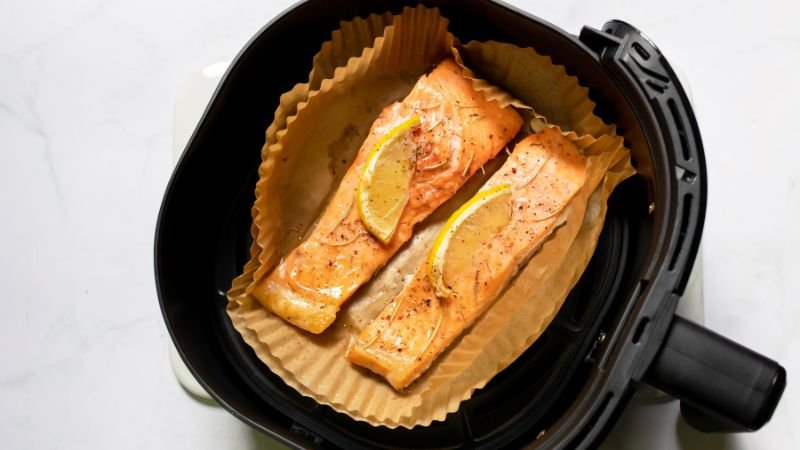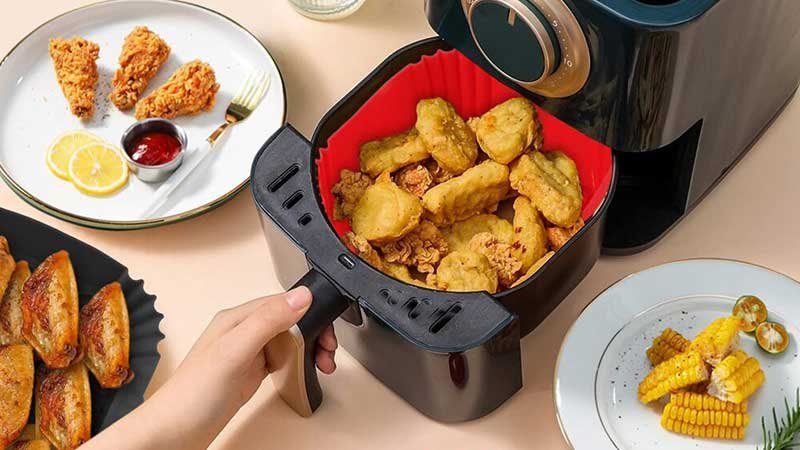Air fryers have revolutionized the way we cook, offering a healthier alternative to traditional frying methods. These innovative appliances use hot air circulation to cook food, resulting in a crispy texture without excessive oil. However, an important aspect of air frying often overlooked is the choice of lining used inside the basket. This article delves into the comparison between two popular options: parchment paper and silicone mats. Understanding the differences, benefits, and limitations of each can greatly enhance your air frying experience.

Parchment Paper in Air Fryers
Parchment paper, a staple in baking, has found its way into the realm of air frying. Made from silicone-infused paper, it is known for its non-stick properties and heat resistance. In air fryers, parchment paper serves as a barrier between the food and the fryer basket, reducing the chances of food sticking and making clean-up a breeze.
Advantages of Parchment Paper
- Non-Stick Surface: Parchment paper ensures that foods like breaded fish, chicken, or even sticky glazed vegetables do not adhere to the basket. This is particularly useful when cooking items that might otherwise break apart or leave a residue.
- Easy Cleanup: After cooking, the parchment can be removed, taking with it any crumbs or drippings. This reduces the need for extensive cleaning and maintains the integrity of the air fryer basket.
- Heat Resistance: Good quality parchment paper can withstand the high temperatures of an air fryer without burning or disintegrating, ensuring that it does not affect the taste or safety of the food.
- Versatility: It can be used for a variety of foods, from baked goods to meats, providing a consistent cooking experience.
Limitations and Precautions
- Air Circulation: Parchment paper can restrict the flow of hot air if not used correctly. It’s important to either use perforated parchment paper designed for air fryers or manually make holes in standard parchment paper to allow for air circulation.
- Size and Placement: The parchment paper must be cut to the size of the air fryer basket. It should not extend up the sides or cover the entire bottom, as this can prevent hot air from circulating properly around the food.
- Fire Hazard: If parchment paper comes in contact with the heating element, it poses a fire risk. It should only be placed in the basket with food on top to weigh it down.
- Environmental Impact: Being a single-use item, parchment paper contributes to waste. Although it’s a convenient option, its disposability might not align with eco-conscious cooking practices.
Real-Life Usage Insights
As a frequent user of an air fryer, I’ve found parchment paper incredibly useful for certain types of cooking. It’s particularly beneficial when I’m in a hurry and don’t have time for extensive clean-up. However, the need to customize the size and ensure proper air flow adds an extra step to the preparation process. I reserve parchment paper for shorter, high-heat cooking cycles to prevent any risk of burning or fire hazards.

Silicone Mats in Air Fryers
Silicone mats, crafted from durable, food-grade silicone, are an innovative tool for air fryer enthusiasts. As a reusable and flexible option, they present an eco-friendly alternative to parchment paper. These mats are designed to withstand the high heat of air fryers, making them a safe and practical choice for various cooking tasks.
Advantages of Silicone Mats
- Durability and Reusability: Unlike parchment paper, silicone mats can be used multiple times, offering a cost-effective and environmentally friendly option. Their resilience against wear and tear makes them a long-term investment for regular air fryer users.
- Heat Resistance: High-quality silicone mats can endure the intense heat inside an air fryer without melting or deforming, ensuring that they don’t release harmful substances or alter the taste of food.
- Non-Stick Surface: Just like parchment paper, silicone mats provide a non-stick surface, reducing the need for additional oil and making the release of food effortless. This feature is particularly beneficial for sticky or delicate dishes.
- Easy Cleaning: Silicone mats are typically dishwasher-safe, making cleanup a simple task. Food residue and oil can be easily washed away, maintaining the cleanliness of both the mat and the air fryer basket.
Limitations and Precautions
- Air Circulation: While silicone mats are generally thinner than parchment paper, they still need to be properly sized and placed to not hinder the air fryer’s circulation. This is crucial for even cooking and achieving the desired crispy texture.
- Compatibility: Not all silicone mats are created equal. Users must ensure that the mat they choose is compatible with their specific air fryer model, both in size and material composition.
- Heat Conductivity: Silicone does not conduct heat as efficiently as metal, which can slightly alter cooking times or temperatures. Users might need to adjust their usual settings when first using silicone mats.
Real-Life Usage Insights
As a regular air fryer user, I appreciate the convenience and sustainability of silicone mats. Their reusability aligns with my eco-friendly kitchen practices. While there’s a slight learning curve in terms of adjusting cooking times, the benefits of reduced waste and easy cleaning outweigh this minor inconvenience.
Quick Comparison: Parchment Paper vs. Silicone Mats for Air Fryers
Choosing the right liner for your air fryer affects not just the outcome of your dishes but also impacts ease of use and environmental footprint. Here’s a quick rundown:
Parchment Paper:
- Durability: Single-use and may burn at very high temperatures.
- Cleaning: No cleaning needed; it’s disposable.
- Environmental Impact: Less sustainable due to single-use.
- Cost: Less expensive initially but can add up over time.
- Heat Resistance: Good, but watch out for burning.
- Ideal for: Quick use and easy clean-up without the need for washing.
Silicone Mats:
- Durability: Reusable and withstands high temperatures.
- Cleaning: Dishwasher safe, requires cleaning after use.
- Environmental Impact: Eco-friendly due to less waste.
- Cost: More expensive upfront, cost-effective over time.
- Heat Resistance: Excellent, without the risk of burning.
- Ideal for: Eco-conscious cooks and frequent air fryer users.
Silicone mats and parchment paper both offer non-stick surfaces for air frying, but the choice between them depends on your priorities: the convenience of disposability or the sustainability of reusability.

Best Practices for Using Parchment Paper and Silicone Mats in Air Fryers
For Parchment Paper
- Proper Sizing: Cut the parchment paper to fit the size of the air fryer basket. Avoid covering the entire bottom or sides, as this can impede air flow and cooking efficiency.
- Prevent Fly-Ups: Always place food on top of the parchment paper before starting the air fryer to prevent the paper from being sucked up into the heating element, which could cause a fire hazard.
- Use Perforated Paper: If possible, opt for perforated parchment paper made specifically for air fryers. The holes allow for better air circulation, leading to more evenly cooked food.
- Avoid High-Temperature Settings: While parchment paper is heat-resistant, extremely high temperatures can still pose a risk. Be cautious with cooking settings that exceed the paper’s heat tolerance.
For Silicone Mats
- Check Compatibility: Ensure the silicone mat fits your air fryer model. It should not be too large or thick, as this can affect cooking performance.
- Placement: Place the silicone mat at the bottom of the air fryer basket. Ensure it does not block the air vents or touch the heating elements.
- Temperature Adjustments: Be aware that silicone mats can affect heat distribution. You may need to experiment with cooking times and temperatures to achieve your desired results.
- Regular Cleaning: Clean the silicone mat after each use to maintain its non-stick properties and prevent any build-up of food residues. Most are dishwasher safe, making this process straightforward.
General Tips
- Preheating: Preheat the air fryer with the parchment paper or silicone mat inside. This helps in temperature management and cooking efficiency.
- Monitoring: Keep an eye on the cooking process, especially when trying new recipes or cooking times. This is important to prevent overcooking or burning.
- Safety First: Never leave the air fryer unattended, and always use heat-resistant gloves when handling hot materials like parchment paper or silicone mats immediately after cooking.
Adopting these best practices can significantly enhance your air frying experience, whether you’re using parchment paper or a silicone mat. By understanding and respecting the properties and limitations of each, you can ensure safe, efficient, and enjoyable cooking.
Conclusion
Recap of Main Points
- Parchment Paper: Offers convenience and a non-stick surface, ideal for single-use applications. It’s great for easy cleanup but has limitations in terms of reusability and environmental impact.
- Silicone Mats: A durable, reusable alternative, silicone mats are environmentally friendly and cost-effective in the long run. They require cleaning but provide a consistent non-stick surface and can withstand repeated use.
Choosing Between Parchment Paper and Silicone Mats
The decision between parchment paper and silicone mats in an air fryer boils down to individual preferences and priorities. If convenience and ease of use are top priorities, parchment paper is an excellent choice. However, for those who prioritize sustainability and long-term cost-effectiveness, silicone mats are the clear winner. Both options offer distinct benefits in terms of cooking performance and ease of maintenance.
Final Thoughts
In the world of air frying, both parchment paper and silicone mats have their place. Parchment paper simplifies the cooking process, especially for those who prefer a quick and easy clean-up. Silicone mats, on the other hand, align with eco-friendly practices, offering durability and reusability. By understanding the strengths and limitations of each, users can make informed decisions that best suit their cooking style and environmental considerations. Ultimately, whether you choose parchment paper or a silicone mat, both can contribute to a delightful and efficient air frying experience.
FAQs
How do I use a silicone mat in an air fryer?
To use a silicone mat in an air fryer, place it at the bottom of the air fryer basket, ensuring it does not block the air vents. Arrange your food on top of the mat and proceed with cooking according to your recipe’s instructions.
Do I need a specific silicone mat for my air fryer brand, like Cosori, Cuisinart, or Ninja?
While many silicone mats are universal, some are designed for specific air fryer models or brands. Always check compatibility with your air fryer’s size and model.
Can silicone baking mats be used in air fryers?
Yes, silicone baking mats can be used in air fryers. However, ensure they are cut to fit the air fryer basket and that they don’t cover the entire bottom to allow for air flow.
Resource:
The Ultimate Guide To Silicone Baking Mats
What should I look out for when buying a silicone mat for my air fryer?
When purchasing a silicone mat for your air fryer, look for one that is BPA-free, food-grade, and able to withstand the temperature range of your air fryer. Also, consider the size to ensure it fits your air fryer basket.
Is it safe to place a silicone mat under or over the door of the air fryer?
Silicone mats should not be placed in a way that obstructs the air fryer’s vents or door. This can disrupt the appliance’s airflow and heat distribution, potentially affecting cooking performance or causing safety issues.
Resources:
Silicone Baking Mat
How to Flatten A Silicone Mat
The Wonderful World of Silicone Mats